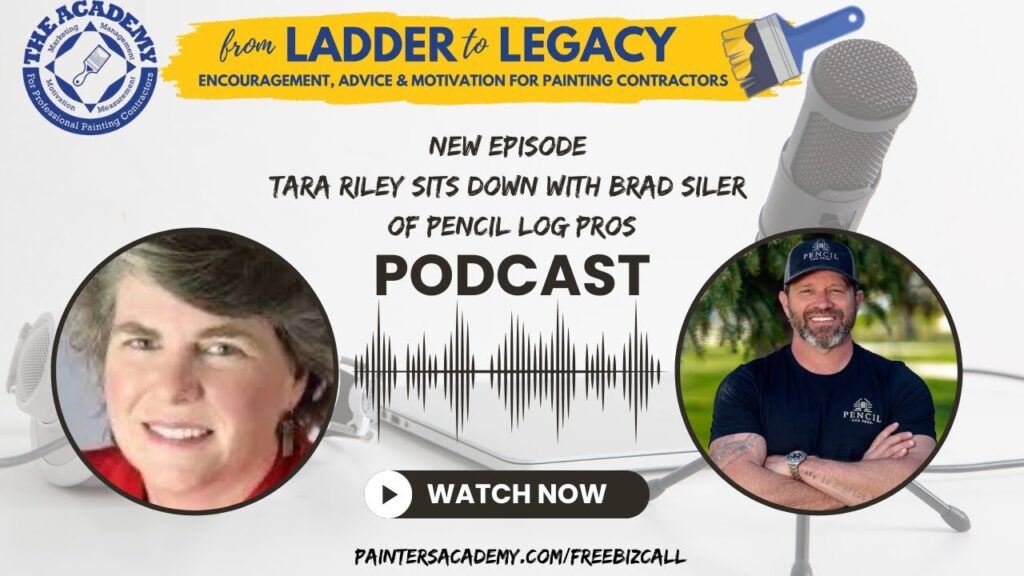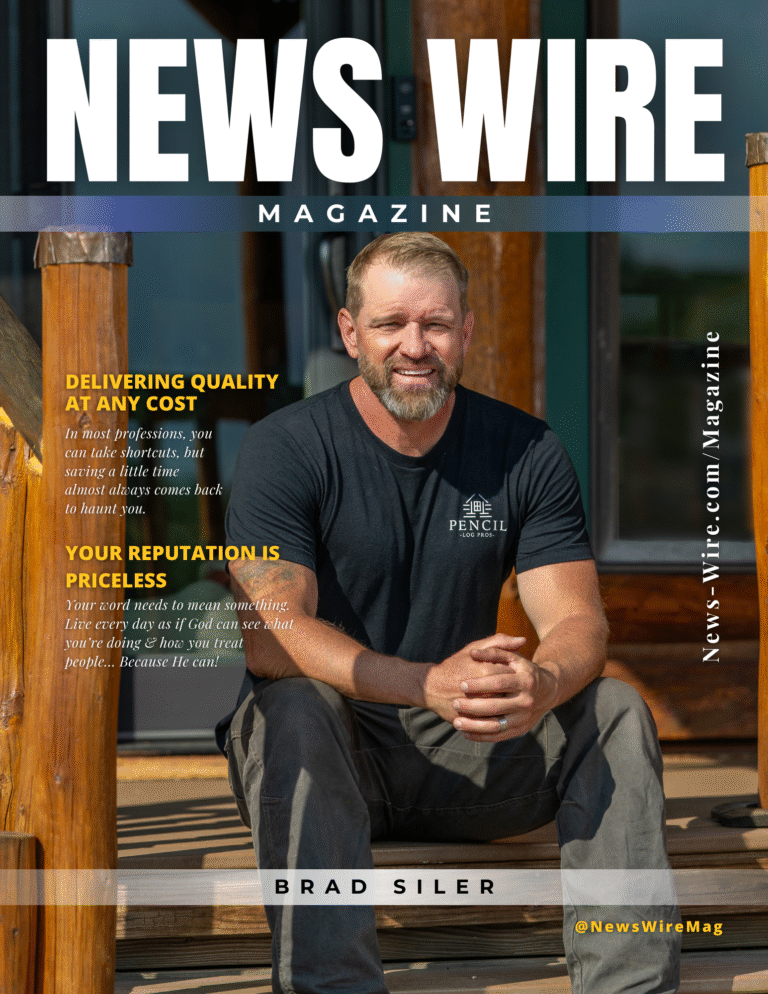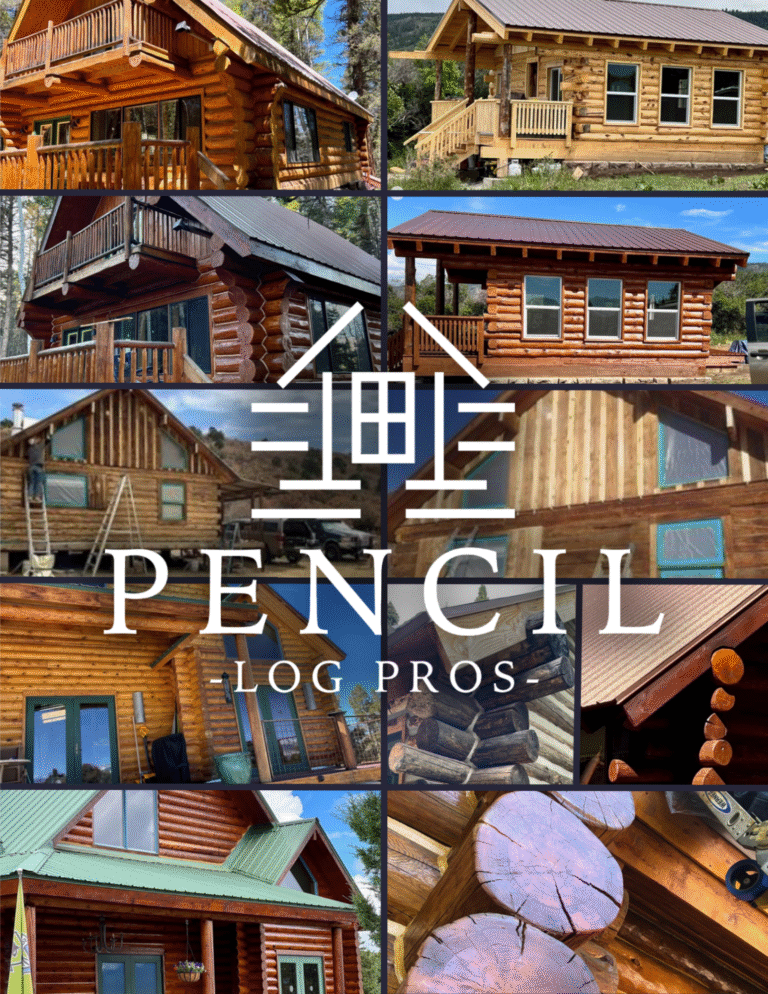Building Legacy in Log Home Care — Pencil Log Pros Owner Brad Siler with Tom Tucker & Tara Riley
The Academy for Professional Painting Contractors featured Pencil Log Pros owner Brad Siler in a wide-ranging conversation with host Tom Tucker and co-host Tara Riley on the “From Ladder to Legacy” series. The interview traces Siler’s transition from military service and fire rescue to building a specialized Colorado company that restores log homes with precision, discipline, and pride. It also unpacks how he scaled operations, why hiring an office manager became the turning point, and what “legacy” looks like to a mountain-state entrepreneur who believes in one mantra: do the hard thing.
The Academy for Professional Painting Contractors: Why This Conversation Matters
The Academy for Professional Painting Contractors exists to elevate trades businesses through practical training and coaching. On “From Ladder to Legacy,” Tom Tucker and Tara Riley spotlight owners who systemize, scale, and lead with purpose. In this episode, they press into the real decisions behind Pencil Log Pros — how a niche was chosen, how a team was built, and which hires unlocked growth. Their questions surface tactics any coatings contractor can implement, while the Colorado-specific context adds color to the craft of log home care.
Who Is Brad Siler? A Disciplined Builder of People, Process, and Product
Brad Siler is the owner of Pencil Log Pros, a Colorado firm specializing in log home restoration, staining, chinking, blasting, rot repair, and deck refinishing. His background spans 12 years in the Navy with multiple deployments, followed by seven years as a firefighter/paramedic in Grand Junction. That combination of grit, service, and high-stakes decision-making bleeds into how he runs crews, standardizes procedures, and communicates with homeowners who expect lasting results on complex substrates like pine, spruce, and cedar.
In the interview with Tom Tucker and Tara Riley, Siler speaks in systems. He breaks down why quality people pay for themselves, how to replace “chuck-in-a-truck” chaos with professional operations, and why early growth requires owners to sacrifice balance — at least for a season — to gain momentum.
Origin Story: From Service to Startup
Siler didn’t set out to become “the log cabin guy.” He followed a traditional path after the military, completed schooling, then served as a fire medic in Grand Junction. Yet a persistent entrepreneurial itch grew louder. He and his wife had the decisive conversation: abandon the safety net and build a company. There would be no Plan B.
Like many trade entrepreneurs, he started with remodeling. Reality diverged from TV glamor, but the work opened doors, relationships, and pattern recognition. He and a partner began seeing recurring requests from log home owners in Western Colorado. The mountains offered a clear signal: the region needed true log care specialists who could manage blasting, chinking, stain systems, and rot problems with a repeatable process.
Niche Discovery: The Instagram Inflection Point
The first few log projects were underbid and grueling. Those hard-won before/after images, however, proved magnetic. Siler posted the transformations, tagged a product vendor, and inbound demand followed. Homeowners started asking the same question: “Are you the log cabin guy?”
That steady drumbeat led to focus. Around 2019, Pencil Log Pros committed to log homes. Specialization fostered better estimating, cleaner scope control, training pathways for field leaders, and brand clarity. What began as a tactical pivot became a strategic identity.
What Pencil Log Pros Actually Does
In the interview, Siler reframes “painting” as comprehensive log home care. The work is more than applying a coating. It requires surface science, substrate testing, and environmental awareness. Key elements include:
- Media Blasting: Removing failed finishes, graying, and contaminants to a consistent profile for optimal adhesion.
- Log Staining: Selecting and applying stain systems suited to UV exposure, elevation, and wood species.
- Chinking & Sealing: Installing flexible sealants that move with the logs, reduce air infiltration, and protect against weather.
- Rot Repair & Log Replacement: Addressing structural integrity and moisture management issues before finishing.
- Deck Refinishing: Restoring adjacent exterior elements to extend the life and look of the overall project.
Because mountain climates deliver intense UV, freeze-thaw cycles, and dry air, the company’s sequencing and prep standards matter as much as the coating itself. Siler emphasizes doing it right the first time, not chasing shortcuts.
Mindset Shift: Good People Pay for Themselves
Asked by Tom Tucker about growth, Siler identifies a single turning point: believing that quality hires are profit centers, not costs. Early on, he hesitated to add overhead roles. Like many owners, he saw field production as obvious leverage and “admin” as an expense. Experience changed that view.
Once he brought in stronger people and paid them to match their lane, the company’s capacity and consistency jumped. Better talent lifted scheduling discipline, change order management, callbacks, and client communication — all of which sharpened margins. The lesson: hesitate on the wrong hire, not the right one.
The Game-Changer: Hiring an Office Manager
Co-host Tara Riley dug into operations, and Siler answered plainly: delaying the office manager was his biggest mistake. Bringing in a strong administrator freed roughly 40% of his time for revenue driving work — sales, marketing, and leadership. That single move reduced bottlenecks, shortened estimate cycles, and created a reliable rhythm for billing and cash flow.
Owners often resist this hire because the return is hard to visualize. Siler’s result makes the case clear: leadership attention is a finite resource. Allocate it to the highest-return activities, and delegate everything that doesn’t demand the owner’s fingerprint.
From Turnover to Ownership: Building the Crew
Early seasons brought the usual churn. But as Pencil Log Pros professionalized, Siler raised standards, compensation, and expectations. He correlates pay bands to performance bands: if a foreman earns $30–$35 per hour, the output, decision-making, and product must match. Clear lanes create fair accountability.
More importantly, he fosters buy-in. People want respect, voice, and visible impact. Siler makes it a point to recognize work, listen closely, and maintain a high bar. The result is stability at the core of the team — the foundation for multi-crew growth and predictable scheduling.
Revenue Trajectory and the Next Strategic Hire
As the office leveled up and field leadership matured, revenue climbed from the low seven figures toward the mid seven figures. Siler’s next target is an experienced, commission-based salesperson. He enjoys selling and plans to mentor the role, but he knows that a dedicated closer will compress cycle times and unlock geographic capacity. The goal: have a pro fall in behind him, then beside him, and eventually in front of him on the sales front so he can continue working on the business.
Proactive vs. Reactive: A Philosophy for Trades Entrepreneurs
Siler is blunt about what it takes to build momentum: aggression beats reaction. No one is coming to save a small business. Owners must move the ball forward every day, often through 70-hour weeks during the early years. Balance is earned later, once the engine runs with its own cadence.
That urgency doesn’t mean panic. It means process. He advocates professionalizing operations: estimating frameworks, repeatable scopes, standardized prep, documented checklists, and daily scorekeeping that shows where profits are made — or lost.
Learning the Game of Business: Mentors and Levels
When his business partner stepped away, Siler chose a different identity: professional operator. He began stacking books, classes, podcasts, and mentors. He sought out people who had already solved the problems he was facing. Each milestone created a new ceiling. What got the company to one level wouldn’t get it to the next. So he found new teachers and added new tools.
In conversation with Tom Tucker and Tara Riley, that posture is consistent. Curiosity is strategy. The leader who learns fastest compounds the quickest.
Leadership in the Field: Why Standards Beat Slogans
On a log home jobsite, standards are the culture. Crews follow a clear sequence:
- Assessment: Document substrate condition, moisture risk, UV exposure, and prior coatings.
- Prep: Masking, protection, targeted repairs, and media blasting to a defined profile.
- Detailing: Sanding, cleaning, dust management, and gap prep for chinking.
- Chinking/Sealing: Install sealant to design spec; verify adhesion and tooling.
- Finish Systems: Apply stain/clear coats per manufacturer mil build and recoat windows.
- QC & Homeowner Walkthrough: Punch list, care instructions, and maintenance plan.
These steps keep the crew aligned, help homeowners understand progress, and ensure the final look matches the bid. Standards protect margins and reputation in equal measure.
Colorado Context: Why Mountain Homes Demand Discipline
Western Colorado brings high UV, rapid temperature swings, and low humidity. Log structures move. Joints open. Sun-exposed elevations weather faster. The only antidote is disciplined prep and durable systems. Siler’s teams don’t cut steps on south- and west-facing walls. They plan staging around weather windows. They target moisture sources early and insist on proper surface profiles before any finish touches wood.
This local context is part of the brand promise. Pencil Log Pros doesn’t just make logs look good. The company fights the climate for the long haul.
Team Retention: Paying for the People You Want
Siler ties retention to three elements:
- Fair Pay: Match wages to the caliber of output you expect.
- Respect: Recognize effort and give every voice a hearing.
- Path: Show employees how performance leads to responsibility and compensation growth.
Seasonal markets create staffing challenges, but a clear value proposition keeps the best people coming back. Structure beats hype.
Standout Quotes from the Interview
“There’s no plan B.” — Brad Siler, Pencil Log Pros
“Good people pay for themselves.” — Brad Siler
“No one’s coming to save you.” — Brad Siler
“Be proactive; always move the ball forward.” — Brad Siler
“Do the hard thing.” — Brad Siler
From Ladder to Legacy: What Legacy Means to Siler
Legacy, to Siler, is durability. Build something that lasts, that serves families and communities, and that can be handed to the next generation — whether that’s his children or future leaders he helps develop. He’s climbed dozens of Colorado 14ers; that lens fits his business view. The path is uphill, the air is thin, and the only way forward is to embrace the steep stuff.
When Tom Tucker evokes Mount Elbert and asks what a mountaintop billboard would say, Siler doesn’t hesitate: “Do the hard thing.”
Actionable Takeaways for Contractors Listening to The Academy for Professional Painting Contractors
- Hire an office manager earlier. Convert owner hours into sales and leadership.
- Define your niche. Specialization clarifies process, training, and brand.
- Systemize prep and QC. Standards protect margin and reputation.
- Recruit for culture and pay for performance. Align wages with expected outcomes.
- Measure what matters daily. Track estimate velocity, close rate, job profitability, and callbacks.
- Invest in learning. Coaches, books, and peer groups collapse timelines.
- Be proactively relentless. Momentum belongs to the operator who moves first.
About Pencil Log Pros
Pencil Log Pros restores, protects, and maintains log homes with a disciplined, military-precise approach. Core services include:
- Full log home restoration
- Media blasting and surface prep
- Chinking and sealing
- Rot repair and log replacement
- Exterior staining and clear coats
- Deck refinishing and protective maintenance
The team works across Western Colorado mountain communities and beyond, applying systems designed for high-UV, high-elevation environments.
Nearby Service Areas
Explore service pages and local expertise:
FAQ
Who interviewed Pencil Log Pros owner Brad Siler?
Tom Tucker and Tara Riley interviewed him on The Academy for Professional Painting Contractors “From Ladder to Legacy” series.
What business lessons did Brad Siler share?
Hire administrative support early, pay for top talent, document standards, learn the game of business, and stay proactive. He distills it to a simple principle: do the hard thing.
How did Pencil Log Pros find its niche?
Early log projects produced compelling before/after results that, once shared, attracted homeowners seeking specialists. The company focused on log homes around 2019 and built systems for blasting, chinking, staining, and structural repairs.
What’s the next growth move for Pencil Log Pros?
Recruit an experienced, commission-based salesperson to accelerate estimates, close rates, and geographic reach while allowing the owner to focus more heavily on scaling.
Why is The Academy for Professional Painting Contractors relevant here?
The platform, led by Tom Tucker and Tara Riley, highlights owners who systemize and scale. Their discussion with Brad Siler offers field-tested practices applicable to any coatings or restoration firm seeking durable growth.
If You Own a Log Home, Choose the Team That Does the Hard Thing
If you want your cabin to perform at altitude, hire specialists who obsess over prep, profile, and protection. Pencil Log Pros brings disciplined project management, clear communication, and meticulous craftsmanship to every log home restoration, staining, chinking, blasting, rot repair, and deck refinishing project. Share your goals, and the team will build a plan that respects your timeline, your budget, and your home’s long-term health.



